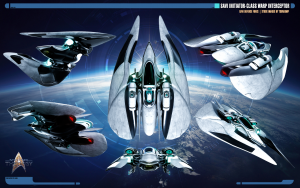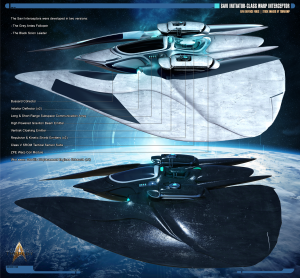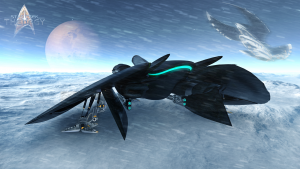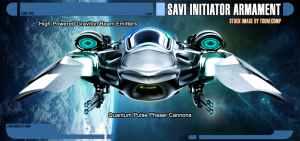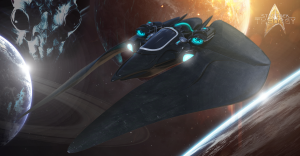Initiator-class Interceptor: Difference between revisions
From Star Trek: Theurgy Wiki
Auctor Lucan (talk | contribs) (Created page with "{| class="wikitable floatright" style="width: 20%; background: #252525; color: white;" | colspan="2" | 300px |- | Name: | Initiator-c...") |
Auctor Lucan (talk | contribs) |
||
| (5 intermediate revisions by the same user not shown) | |||
| Line 12: | Line 12: | ||
|- | |- | ||
| Production Status: | | Production Status: | ||
| Active | | Active<br>(Unknown even to Asurians) | ||
|- | |- | ||
| Role: | | Role: | ||
| Line 114: | Line 114: | ||
| colspan="2" | [[File:Sheromi-Dreadnought.png|300px]] | | colspan="2" | [[File:Sheromi-Dreadnought.png|300px]] | ||
|} | |} | ||
This was the fourth generation of the '''Initiator-class Interceptor'''. The Initiator was a craft belonging to the [[Savi]] (also called the [[Sheromi]] by the [[Asurian]]s), which was designed for Flotilla defence. The Initiator was made to strike fast, hard, cloak, and then regroup for another pass if so necessary. With its heavy graviton beam emitters and ability to hold cloak while not firing on the opponent, each pass that these interceptors made seemed to come out of nowhere. They were not deployed alone either, but would attack in large numbers with synchronised strikes. | This was the fourth generation of the '''[[Initiator-class Interceptor]]'''. The Initiator was a craft belonging to the [[Savi]] (also called the [[Sheromi]] by the [[Asurian]]s), which was designed for Flotilla defence. The Initiator was made to strike fast, hard, cloak, and then regroup for another pass if so necessary. With its heavy graviton beam emitters and ability to hold cloak while not firing on the opponent, each pass that these interceptors made seemed to come out of nowhere. They were not deployed alone either, but would attack in large numbers with synchronised strikes. | ||
The Initiator-class Interceptors were the kind of defence crafts that were built in the Aerodrome of ''[[the Versant]]'', along with the other three [[Precept]] ships in the [[Savi]] Flotilla during the end of the 24<sup>th</sup> century. They were also built in two versions, the black one meant for the Scion leader of the [[Savi]] Defence Forces, and the grey for the Ante followers. | The Initiator-class Interceptors were the kind of defence crafts that were built in the Aerodrome of ''[[the Versant]]'', along with the other three [[Precept]] ships in the [[Savi]] Flotilla during the end of the 24<sup>th</sup> century. They were also built in two versions, the black one meant for the Scion leader of the [[Savi]] Defence Forces, and the grey for the Ante followers. | ||
| Line 129: | Line 129: | ||
== Features == | == Features == | ||
[[File:SCION-LEADER-LANDED.png|left|300px]]The Initiator-class carried a few features considered new or unusual compared to [[Federation]] fighters, since the [[Savi]] were not a part of the [[Federation]] and did not have direct contact with them - merely studying them along with all other species that held their interest. | [[File:SCION-LEADER-LANDED.png|left|300px]]The Initiator-class carried a few features considered new or unusual compared to [[Federation]] fighters, since the [[Savi]] were not a part of the [[Federation]] and did not have direct contact with them - merely studying them along with all other species that held their interest. | ||
==== Zero-Point Energy Drive==== | |||
Hundreds of years ago, the [[Savi]] solved the cosmological constant problem (which was one of the greatest unsolved mysteries among [[Federation]] physicists during the twenty-fourth century). Many of those physicists believed that "the vacuum held the key to a full understanding of nature", but whether or not that was true, the [[Savi]] learned to harness small localised fluctuations in the zero energy state (zero point) to derive power. Through their research and adaptations, they made it so that the zero-point radiation of the vacuum was of an order of magnitude greater than nuclear energy. Since their initial success with this technology, they calibrated it to be the prime energy source for the Flotilla. The [[Precept]] ships had the largest ZPE reactors, but even the Initiator-class interceptors had smaller drive cores with the same technology. | |||
==== Layered Shielding ==== | ==== Layered Shielding ==== | ||
| Line 142: | Line 145: | ||
Ventrak Cloaking was a type of cloaking device developed by the [[Savi]] for the purpose of remaining unseen while observing. An Initiator's shields dropped automatically on activation of the cloaking device. This left the interceptor vulnerable for a second before the cloaking field formed, and a half second after it dropped. | Ventrak Cloaking was a type of cloaking device developed by the [[Savi]] for the purpose of remaining unseen while observing. An Initiator's shields dropped automatically on activation of the cloaking device. This left the interceptor vulnerable for a second before the cloaking field formed, and a half second after it dropped. | ||
While cloaking, the initiator's movement did not set off any motion tracking sensors, nor did light 'shimmer' around it. Most modern day sensors couldn't pick up on a Ventrak cloaked object, and Ventrak cloaking did not leave behind any particles to detect it, making it a nearly 'perfect' cloaking device. The energy spike of the ZPE- | While cloaking, the initiator's movement did not set off any motion tracking sensors, nor did light 'shimmer' around it. Most modern day sensors couldn't pick up on a Ventrak cloaked object, and Ventrak cloaking did not leave behind any particles to detect it, making it a nearly 'perfect' cloaking device. The energy spike of the ZPE-core when powering weapon systems and shielding interfered, however, with the Ventrak cloak, and to fire weapons or raise shields required the cloaking to be dropped. | ||
===Kkrek Alloy=== | ===Kkrek Alloy=== | ||
Kkrek was a thin, silver-translucent, non-Newtonian liquid at room temperature, a mixture of both natural and lab-created elements. It was a super-hydrophobic alloy that did not bond easily in the presence of other elements. It hardened permanently when exposed to high heats. The surface of heated Kkrek was extremely smooth and reduced friction to near-zero. It could sometimes feel chilly to the touch. | Kkrek was a thin, silver-translucent, non-Newtonian liquid at room temperature, a mixture of both natural and lab-created elements. It was a super-hydrophobic alloy that did not bond easily in the presence of other elements. It hardened permanently when exposed to high heats. The surface of heated Kkrek was extremely smooth and reduced friction to near-zero. It could sometimes feel chilly to the touch. | ||
Kkrek alloy coating deteriorated over the span of several centuries, though hard strikes to the surface of the alloy could sometimes break the coating, leaving the surface below open to damage. Although rain and wind slid right off the alloy, shail could sometimes cause hairpin cracks that would reduce the coating's overall effectiveness, and | Kkrek alloy coating deteriorated over the span of several centuries, though hard strikes to the surface of the alloy could sometimes break the coating, leaving the surface below open to damage. Although rain and wind slid right off the alloy, shail could sometimes cause hairpin cracks that would reduce the coating's overall effectiveness, and asteroid-collisions could sometimes tear off chunks of coating all together. | ||
== Weapon Systems == | == Weapon Systems == | ||
| Line 164: | Line 167: | ||
== Ejection Systems == | == Ejection Systems == | ||
[[File:SCION-LEADER-INITIATOR.png|left|300px]]Since the Initiators would either - according to the Code ([[Savi]] law) - cloak and withdraw, | [[File:SCION-LEADER-INITIATOR.png|left|300px]]Since the Initiators would either - according to the Code ([[Savi]] law) - cloak and withdraw, or if that wasn't an option, self-destruct the fighters if defeat was imminent, the Initiators did not have any pilot ejection capabilities. This, to preserve their technology and DNA to from the scientists of the enemy, and not allow a pilot to have the option of saving his own life. The self-destruct sequence had an overpowered yield because of its ZPE-core, but before the detonation, the cockpit was bathed in a bio-disruption field that left no traces of the [[Savi]] pilot. | ||
The only exception could be found in the black Scion Leader interceptors, which had a micro transporter system installed in order to - possibly - save the life of the Scion. This transport was only initiated if the Initator was close enough to let the Scion be beamed safely aboard a [[Savi]] ship. If the Initiator was out of range, the bio-disruptor field protocol would be triggered nonetheless. | The only exception could be found in the black Scion Leader interceptors, which had a micro transporter system installed in order to - possibly - save the life of the Scion. This transport was only initiated if the Initator was close enough to let the Scion be beamed safely aboard a [[Savi]] ship. If the Initiator was out of range, the bio-disruptor field protocol would be triggered nonetheless. | ||
[[Category:Technical Specifications]] | [[Category:Technical Specifications]] | ||
[[Category:Fighters & Shuttles]] | [[Category:Fighters & Shuttles]] | ||
[[Category:Fighters & Shuttles Specifications]] | |||
Latest revision as of 15:04, 9 November 2018
This was the fourth generation of the Initiator-class Interceptor. The Initiator was a craft belonging to the Savi (also called the Sheromi by the Asurians), which was designed for Flotilla defence. The Initiator was made to strike fast, hard, cloak, and then regroup for another pass if so necessary. With its heavy graviton beam emitters and ability to hold cloak while not firing on the opponent, each pass that these interceptors made seemed to come out of nowhere. They were not deployed alone either, but would attack in large numbers with synchronised strikes.
The Initiator-class Interceptors were the kind of defence crafts that were built in the Aerodrome of the Versant, along with the other three Precept ships in the Savi Flotilla during the end of the 24th century. They were also built in two versions, the black one meant for the Scion leader of the Savi Defence Forces, and the grey for the Ante followers.
Production History
The Savi employed a great number of research and exploration vessels in their ceaseless scientific studies, but before 2374, dependable engagement spacecraft were scarce. The the line of Initiator warp interceptors were built in the interest of Flotilla defence, should their ships be compromised by outside forces. Their role was to intercept and tie up enemy ships in large numbers and hard, synchronised strikes while the ships of the Flotilla could enter transwarp speed and vanish.
Once the ships of the Flotilla were safe, the Initiators would neutralise the threat and ensure that there were no surviving witnesses. If the opposing forces were too strong, the Initiators would either - according to the Code (Savi law) - cloak and withdraw, and if that wasn't an option, self-destruct the fighters. This, to preserve their technology and DNA to from the scientists of the enemy. Since the Savi had entered few engagements due to their clandestine nature, the retreat or self-destruct protocols had never been utilised as of March 2381.
The first generation of the Initiator-class interceptors had Ventrak cloaking and RF Cavity Thruster engines, which were later replaced with Gravitic Displacement Engines, giving the interceptors their trademark maneuverability and decreasing the amount of power consumed by the engine at any given time. The third generation of these combat crafts were the first class to implement the liquid alloy known as Kkrek.
The final - fourth - generation were equipped with graviton beam emitters in addition to the initial armament of quantum pulse phaser cannons. The graviton emitters disrupted shields, and then caused damage via gravimetric shear against the hull and effectively ripped it apart. These graviton beams were not akin to traditional Alpha Quadrant weaponry that used energy transfer, like phasers or disruptors.
Features
The Initiator-class carried a few features considered new or unusual compared to Federation fighters, since the Savi were not a part of the Federation and did not have direct contact with them - merely studying them along with all other species that held their interest.
Zero-Point Energy Drive
Hundreds of years ago, the Savi solved the cosmological constant problem (which was one of the greatest unsolved mysteries among Federation physicists during the twenty-fourth century). Many of those physicists believed that "the vacuum held the key to a full understanding of nature", but whether or not that was true, the Savi learned to harness small localised fluctuations in the zero energy state (zero point) to derive power. Through their research and adaptations, they made it so that the zero-point radiation of the vacuum was of an order of magnitude greater than nuclear energy. Since their initial success with this technology, they calibrated it to be the prime energy source for the Flotilla. The Precept ships had the largest ZPE reactors, but even the Initiator-class interceptors had smaller drive cores with the same technology.
Layered Shielding
Initiators had two kinds of shielding by default, both stemming from the dorsal shield emitters, kinetic and repulsive.
The Initiator's gravitational force field (kinetic shielding) was a separate shielding system used specifically to deflect pre-warp weaponry, such as missiles, bullets, arrows, and rocks. This kinetic shielding was a powerful force spread out over an area just a little larger than the repulsive shield. It was capable of exerting approximately 30-50 tons of force on a given area, depending on how much power was routed to the kinetic shielding. While the interceptor was moving, it was possible for it to run into another mass, using this force field. An interceptor moving at 50 MPH with kinetics at over 20 tons would exert a lot of damage. Liftoff from the ground with kinetics on would leave an imprint on the ground.
A significant technical improvement compared to Savi research vessels was the inclusion of repulsive shielding. The concept of the shielding was to disperse the incoming fire and subsequent damage through oscillation of the shields, creating a ripple effect that spread the impact out to reduce the overall magnitude. In practical studies by the Savi, this was shown to reduce energy loss by 35%. It also improved shielding near the front and back, where the shield bubble was less pronounced. Impact with these areas actually saw a 50% decrease in shield energy loss as the thinner surface area actually saw some of the blast spread off the shields entirely into empty space.
Kinetics and deflector shielding could both be active at the same time, but neither could be at full power while the other was operating.
Ventrak Cloaking
Ventrak Cloaking was a type of cloaking device developed by the Savi for the purpose of remaining unseen while observing. An Initiator's shields dropped automatically on activation of the cloaking device. This left the interceptor vulnerable for a second before the cloaking field formed, and a half second after it dropped.
While cloaking, the initiator's movement did not set off any motion tracking sensors, nor did light 'shimmer' around it. Most modern day sensors couldn't pick up on a Ventrak cloaked object, and Ventrak cloaking did not leave behind any particles to detect it, making it a nearly 'perfect' cloaking device. The energy spike of the ZPE-core when powering weapon systems and shielding interfered, however, with the Ventrak cloak, and to fire weapons or raise shields required the cloaking to be dropped.
Kkrek Alloy
Kkrek was a thin, silver-translucent, non-Newtonian liquid at room temperature, a mixture of both natural and lab-created elements. It was a super-hydrophobic alloy that did not bond easily in the presence of other elements. It hardened permanently when exposed to high heats. The surface of heated Kkrek was extremely smooth and reduced friction to near-zero. It could sometimes feel chilly to the touch.
Kkrek alloy coating deteriorated over the span of several centuries, though hard strikes to the surface of the alloy could sometimes break the coating, leaving the surface below open to damage. Although rain and wind slid right off the alloy, shail could sometimes cause hairpin cracks that would reduce the coating's overall effectiveness, and asteroid-collisions could sometimes tear off chunks of coating all together.
Weapon Systems
These were the weapon systems of the 4th generation Initiators:
Graviton Beam Emitters
Each Overseer was outfitted with two deflector dishes. Unlike on the Overseer saucers, the deflectors not the graviton emitters on the Initiators. The aquamarine beams were fired from top-mounted emitters. These emitters carried a very high destructive yield compared to their relatively small size. The beams both deteriorated shields at a quick rate, and then tore the targets apart with their gravitational shear. A Federation fighter's shields couldn't withstand this kind of beam for more than a second or two until its deflector shields were depleted, and then the hull was split open on the fourth second. Given the fact that the beam's diameter was over 2 meter wide, a fighter could be severed in half with a single hit. With a precise aim, these beams could pose a serious threat to capital ships as well.
The aquamarine beam's shearing effect held no inherent energy that could ignite a target's present on-board components. The difference could be illustrated when comparing a steel rod being rammed with enough force to pass through a person's soft tissues, instead of an energy beam burning through the body. The steel rod wouldn't ignite anything, but it would make the target bleed. It was a piercing, artificial gravitational force, so if no critical parts of a starship or fighter was hit, the ship could remain space-borne. There might be indirect effects, not caused by the beam itself, but as a result of the penetration.
The range of the beam was virtually optical, the force abating hundreds of miles away, and could pierce any number of ships if lined up in front of each other. The detriment of this weapon system was that they were difficult to aim with, and swift evasive manoeuvres could save the target from being hit.
Quantum Pulse Phaser Cannons
These under-slung cannons served for rapid-fire assault against hostile small-craft and incoming torpedoes. With a yield higher than that of the Federation's Type-U+ pulse phaser cannons, they were more or less equal to the Rawley cannons that could be found on the AC-347 Knight-class Interceptors. The quantum pulse phaser cannons had a swivel function that allowed them to be pointed to the aft of the Initiator too, which was utilized if the Savi pilot was being pursued or fired upon from behind. With a fire-rate of 100 bolts per minute, they were an important complement to the high-powered but slower graviton beam emitters.
Neither weapon system could, however, be fired while the interceptor was cloaked.
Ejection Systems
Since the Initiators would either - according to the Code (Savi law) - cloak and withdraw, or if that wasn't an option, self-destruct the fighters if defeat was imminent, the Initiators did not have any pilot ejection capabilities. This, to preserve their technology and DNA to from the scientists of the enemy, and not allow a pilot to have the option of saving his own life. The self-destruct sequence had an overpowered yield because of its ZPE-core, but before the detonation, the cockpit was bathed in a bio-disruption field that left no traces of the Savi pilot.
The only exception could be found in the black Scion Leader interceptors, which had a micro transporter system installed in order to - possibly - save the life of the Scion. This transport was only initiated if the Initator was close enough to let the Scion be beamed safely aboard a Savi ship. If the Initiator was out of range, the bio-disruptor field protocol would be triggered nonetheless.
